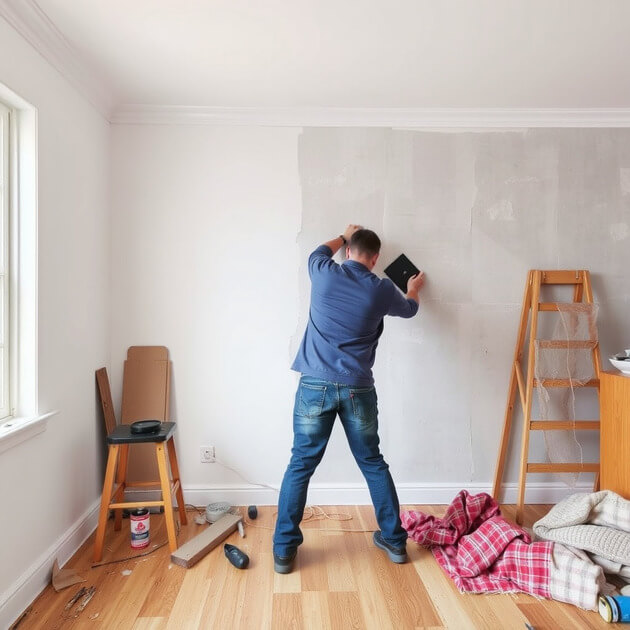 Introduction to home renovation on a budget
Introduction to home renovation on a budget
Embarking on a home renovation project can be an exciting yet daunting endeavor, especially when you’re working with a tight budget. As a homeowner, I understand the desire to create a beautiful and functional living space while being mindful of financial constraints.
Fortunately, with a little creativity and strategic planning, it’s possible to achieve a stunning renovation without breaking the bank.
In this comprehensive guide, I’ll share seven tried-and-true hacks that have helped me and countless others save significant amounts of money on renovation costs.
From setting realistic budgets to maximizing savings through repurposing and recycling, we’ll explore a range of cost-effective strategies that can breathe new life into your home without draining your wallet.
Setting a realistic budget for your renovation project
Before embarking on any renovation project, it’s crucial to establish a realistic budget. This step involves carefully assessing your financial situation, prioritizing your needs and wants, and allocating funds accordingly.
Start by determining how much you can comfortably afford to spend without compromising your financial stability.
Consider factors such as your income, existing debts, and long-term goals. Once you have a clear understanding of your financial limitations, you can begin to allocate funds for various aspects of the renovation, such as materials, labor, and unexpected expenses.
Remember, it’s always better to overestimate your costs than to underestimate them. Leaving room for contingencies will prevent you from running out of funds midway through the project, which can lead to costly delays and additional expenses.
Prioritizing your renovation needs and wants

Not all renovation projects are created equal, and it’s essential to prioritize your needs and wants to ensure you’re allocating your budget effectively.
Begin by identifying the areas of your home that require immediate attention, such as structural repairs, plumbing issues, or safety concerns. These should take precedence over cosmetic upgrades or luxury additions.
Next, make a list of your desired renovations and rank them based on their importance and impact on your daily life. For example, a functional kitchen or bathroom renovation may take priority over updating a guest bedroom or adding a home theater.
By prioritizing your needs and wants, you can focus your resources on the most critical areas, ensuring that your renovation budget is spent wisely and delivering the greatest return on investment.
Negotiating and getting the best deals with contractors
If you decide to hire contractors for your renovation project, it’s essential to negotiate and get the best deals possible.
Start by obtaining multiple quotes from reputable contractors in your area. This not only allows you to compare prices but also gives you leverage in negotiations.
When reviewing quotes, pay close attention to the details, including the scope of work, materials included, and any additional fees or charges. Don’t be afraid to ask questions and clarify any ambiguities to ensure you’re comparing apples to apples.
Once you’ve narrowed down your options, it’s time to negotiate. Be respectful but firm in your approach, and don’t be afraid to walk away if a contractor is unwilling to meet your reasonable demands.
Consider offering to pay in cash or upfront for a discount, or propose alternative payment arrangements that may be more favorable to both parties.
Maximizing savings through repurposing and recycling

One of the most effective ways to save money on a renovation project is to repurpose and recycle materials whenever possible. This not only reduces your overall material costs but also contributes to a more sustainable and eco-friendly approach.
Start by taking inventory of the items in your home that can be repurposed or reused in your renovation. For example, you may be able to refinish an old piece of furniture or repurpose doors or cabinets in a new space.
Additionally, consider salvaging materials from demolition or deconstruction projects, such as wood beams, bricks, or architectural elements.
Recycling can also play a significant role in reducing your renovation costs. Instead of purchasing new materials, consider sourcing recycled or reclaimed items like countertops, flooring, or even appliances.
Not only will this save you money, but it also helps divert waste from landfills and reduces your environmental impact.
Financing options for budget-friendly renovations
Even with careful budgeting and cost-saving strategies, some renovation projects may require additional financing. Fortunately, there are several options available to help you fund your renovation without breaking the bank.
One popular option is a home equity loan or line of credit, which allows you to borrow against the equity you’ve built up in your home. These loans often come with competitive interest rates and flexible repayment terms, making them a viable choice for larger renovation projects.
Another option is a personal loan or credit card with a low-interest introductory rate. While these options may have higher interest rates in the long run, they can provide the necessary funds to complete smaller renovations or cover unexpected expenses.
Additionally, consider exploring government-backed programs or grants specifically designed to assist homeowners with renovations, such as energy-efficiency upgrades or accessibility modifications.
Common mistakes to avoid when renovating on a budget
While renovating on a budget can be a rewarding experience, it’s essential to be aware of common pitfalls that can derail your plans and lead to costly mistakes.
Here are some common mistakes to avoid:

- Underestimating costs: Failing to account for hidden expenses, such as permits, inspections, or unexpected repairs, can quickly blow your budget.
- Cutting corners on quality: While cost-saving is essential, compromising on quality materials or workmanship can lead to costly repairs or replacements down the line.
- Neglecting proper planning: Rushing into a renovation without a well-thought-out plan can result in costly mistakes, delays, and potential safety issues.
- Ignoring resale value: While personal preferences are important, it’s crucial to consider the potential impact of your renovation choices on your home’s resale value.
- Failing to prioritize: Trying to tackle too many projects simultaneously can lead to overwhelm, burnout, and potential budget overruns.
By being mindful of these common pitfalls, you can better navigate the challenges of renovating on a budget and increase your chances of achieving a successful and cost-effective outcome.
Renovation cost-cutting hacks
Now that we’ve explored the fundamental strategies for renovating on a budget, let’s dive into some specific cost-cutting hacks that can help you maximize your savings:
- Shop for discounted materials: Keep an eye out for sales, clearance items, and discontinued products at home improvement stores and specialty retailers. These deeply discounted materials can save you a significant amount of money on your renovation projects.
- Embrace open-source design: Instead of paying for expensive architectural plans or hiring a designer, consider utilizing open-source design resources and online tutorials to create your own renovation plans and designs.
- Rent or borrow tools: Rather than purchasing expensive tools that you may only use once or twice, consider renting or borrowing them from friends, family, or tool libraries in your area.
- Opt for sweat equity: If you have the time and skills, tackling certain renovation tasks yourself can save you a substantial amount on labor costs. However, be realistic about your abilities and prioritize safety.
- Refinish instead of replacing: Rather than completely replacing items like cabinets, countertops, or flooring, consider refinishing or resurfacing them for a fresh, updated look at a fraction of the cost.
- Embrace multi-purpose spaces: By designing rooms that can serve multiple functions, you can maximize the use of your space and potentially eliminate the need for costly additions or expansions.
- Leverage energy-efficient upgrades: Many utility companies and government programs offer rebates or incentives for energy-efficient upgrades, such as insulation, windows, or appliances. These upgrades can not only save you money on your renovation but also lead to long-term savings on your utility bills.
Remember, renovating on a budget is a marathon, not a sprint. By implementing these cost-cutting hacks and remaining patient and flexible throughout the process, you can achieve your desired results without breaking the bank.
If you’re ready to embark on your budget-friendly renovation journey, consider subscribing to our newsletter for more cost-saving tips, DIY tutorials, and inspiration. Simply enter your email address below, and we’ll keep you informed every step of the way.
Conclusion: Achieving a stunning renovation without breaking the bank
Renovating on a budget is not about sacrificing quality or style; it’s about being strategic, creative, and resourceful.
Embrace the challenge, celebrate the small victories, and revel in the satisfaction of transforming your living space into a beautiful, functional, and budget-friendly oasis.
So, roll up your sleeves, gather your tools, and get ready to embark on an exciting and cost-effective renovation journey!

 Introduction to home renovation on a budget
Introduction to home renovation on a budget